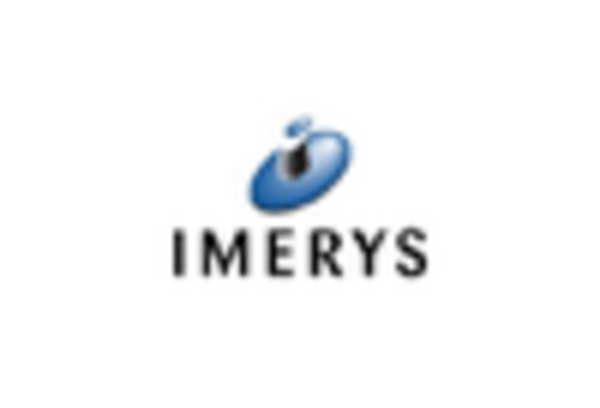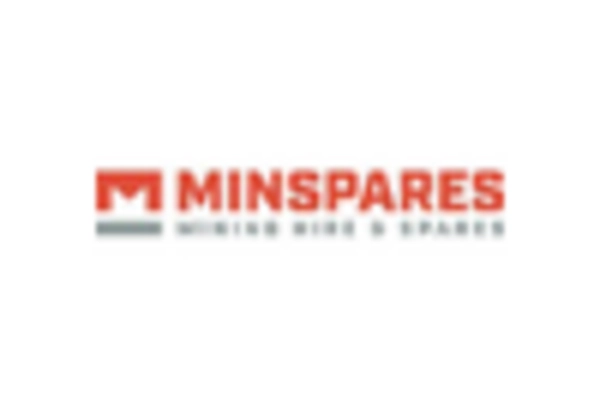Growth in Construction Activities
The Nepheline Market is poised to benefit from the ongoing growth in construction activities across various regions. As urbanization accelerates, the need for construction materials, including glass and ceramics, is on the rise. In 2025, the construction sector is expected to witness a significant uptick, with investments in infrastructure projects and residential developments. Nepheline Market, being a key ingredient in the production of glass and ceramics, is likely to see increased consumption as builders and manufacturers seek materials that offer durability and aesthetic appeal. The integration of nepheline in construction materials not only enhances their properties but also aligns with sustainability goals, as it can reduce the carbon footprint associated with traditional materials. This growth trajectory in construction activities presents a promising opportunity for the Nepheline Market to expand its footprint.
Increasing Environmental Regulations
The Nepheline Market is influenced by the increasing stringency of environmental regulations aimed at reducing the ecological impact of industrial processes. As governments and organizations prioritize sustainability, there is a growing emphasis on sourcing materials that are less harmful to the environment. Nepheline Market, with its natural origins and lower carbon footprint compared to synthetic alternatives, is becoming a preferred choice for manufacturers. In 2025, compliance with these regulations is expected to drive demand for nepheline, particularly in industries such as ceramics and glass, where sustainable practices are increasingly valued. This shift not only aligns with regulatory requirements but also appeals to environmentally conscious consumers, thereby enhancing the market potential for nepheline. Companies that proactively adapt to these regulations may find new opportunities within the Nepheline Market.
Rising Demand for Glass and Ceramics
The Nepheline Market is experiencing a notable increase in demand for glass and ceramics, which are primary applications of nepheline. As industries seek to enhance the quality and durability of their products, nepheline serves as a vital raw material due to its low expansion properties and high alumina content. In 2025, the demand for glass is projected to grow at a compound annual growth rate of approximately 4.5%, driven by the construction and automotive sectors. This trend indicates a robust market for nepheline, as manufacturers increasingly incorporate it into their formulations to improve performance. Furthermore, the ceramics segment is also expanding, with a focus on high-performance ceramics for various applications, including electronics and aerospace. This rising demand underscores the importance of the Nepheline Market in meeting the evolving needs of these sectors.
Diversification of End-Use Industries
The diversification of end-use industries is a significant driver for the Nepheline Market. As various sectors, including automotive, electronics, and construction, explore the benefits of nepheline, the market is likely to expand. In 2025, the automotive industry is anticipated to adopt nepheline in the production of lightweight and durable components, enhancing vehicle performance and fuel efficiency. Similarly, the electronics sector is increasingly utilizing nepheline in the manufacturing of high-performance ceramics for capacitors and insulators. This diversification not only broadens the application scope of nepheline but also mitigates risks associated with reliance on a single industry. As more industries recognize the advantages of incorporating nepheline into their products, the Nepheline Market is expected to experience sustained growth and innovation.
Technological Innovations in Processing
Technological advancements in the processing of nepheline are transforming the Nepheline Market. Innovations in extraction and processing techniques are enhancing the efficiency and quality of nepheline production. For instance, the adoption of advanced milling and purification technologies is enabling manufacturers to produce higher-grade nepheline with improved properties. This is particularly relevant as industries demand more specialized materials for applications in ceramics and glass. In 2025, the market is likely to witness a shift towards more automated and environmentally friendly processing methods, which could lead to cost reductions and increased output. As a result, companies that invest in these technological innovations may gain a competitive edge in the Nepheline Market, positioning themselves favorably in a rapidly evolving landscape.
















Leave a Comment